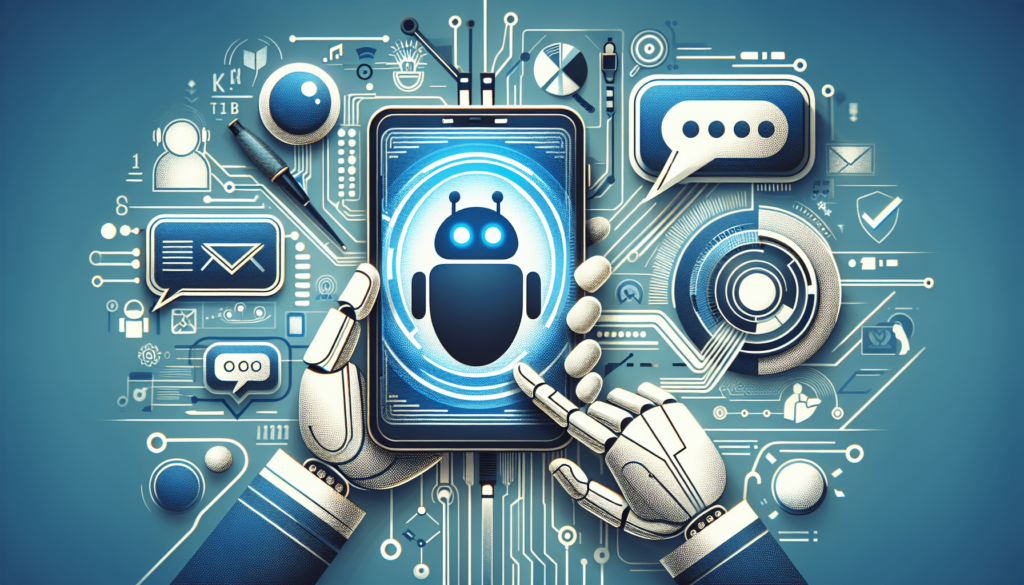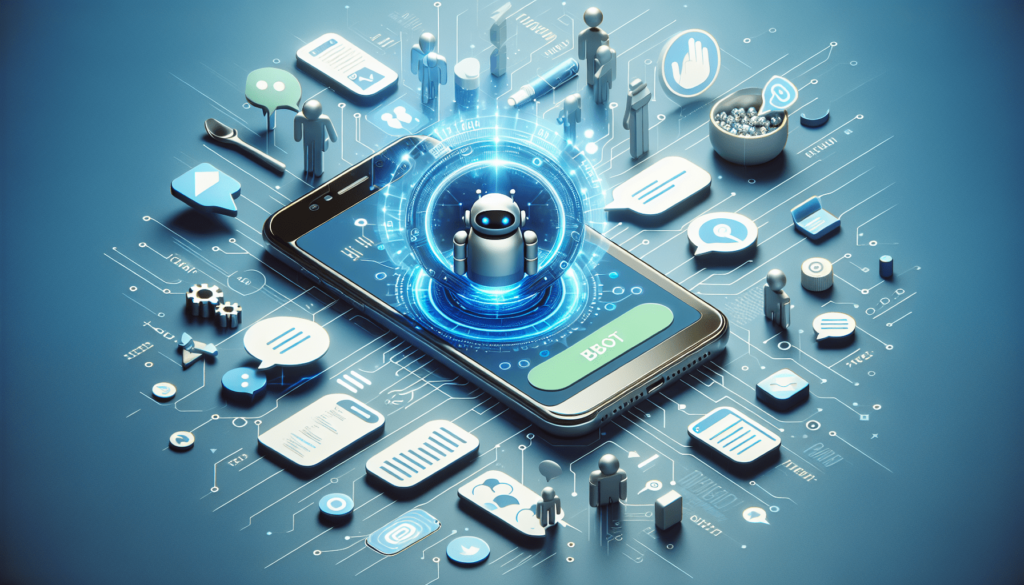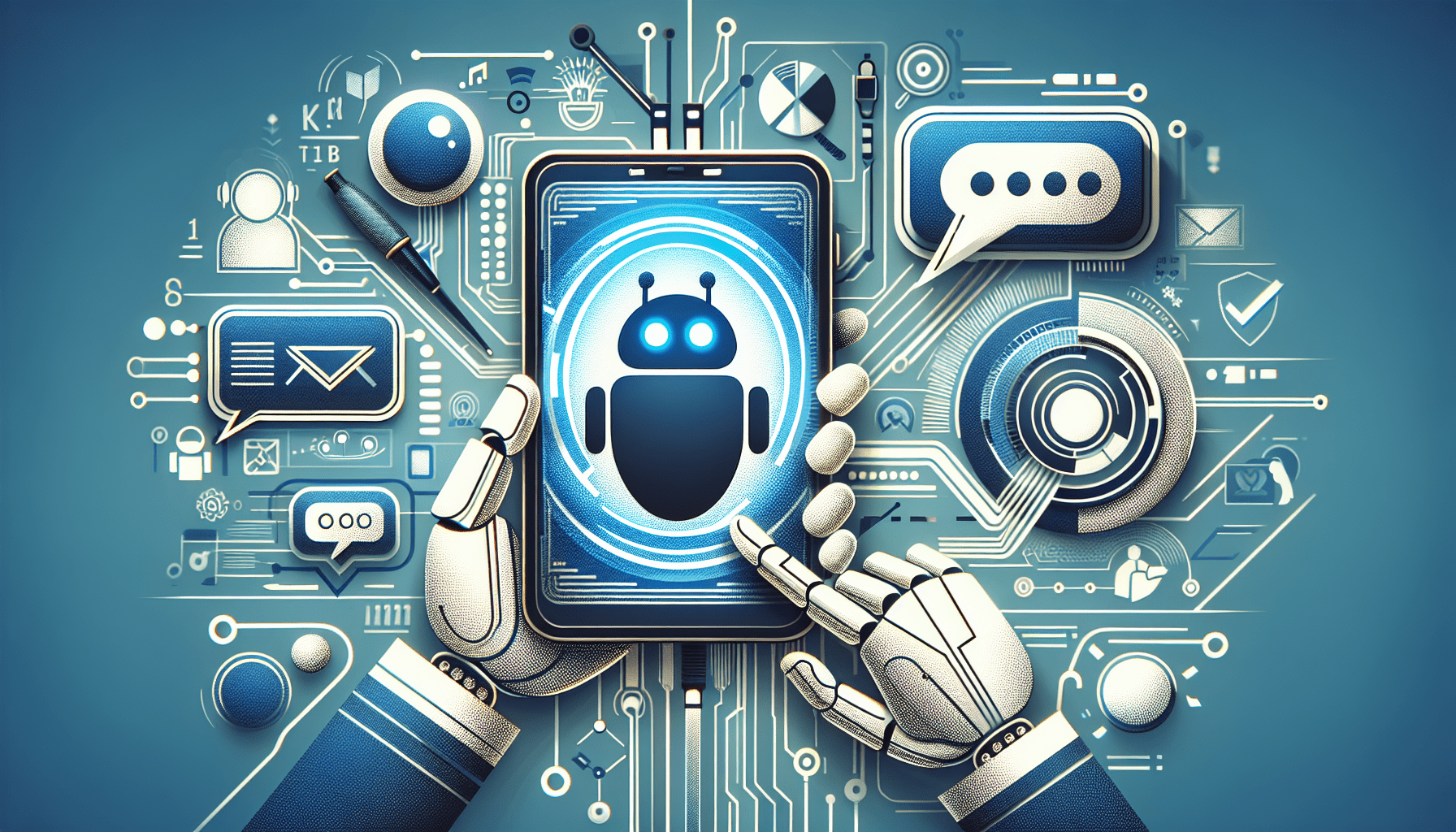Imagine how much more efficient your marketing efforts could be with the help of chatbots. By integrating chatbots into your marketing strategy, you can automate various tasks and engage with your audience in a whole new way. Say goodbye to monotonous customer support queries and hello to personalized interactions that drive conversions. In this article, we will explore the benefits of integrating chatbots into your marketing strategy and provide you with practical tips on how to get started. Get ready to revolutionize your marketing efforts and see your business thrive like never before.
What is a chatbot?
Definition and purpose of a chatbot
A chatbot is a computer program designed to simulate human conversation through text or voice interactions. It uses Artificial Intelligence (AI) and Natural Language Processing (NLP) algorithms to understand and respond to user queries and provide information or complete tasks. The purpose of a chatbot is to streamline customer interactions, automate repetitive tasks, and enhance overall user experience.
Types of chatbots
There are two main types of chatbots: rule-based chatbots and AI-powered chatbots.
-
Rule-based chatbots: These chatbots follow a pre-determined set of rules and responses. They are programmed to recognize specific keywords or phrases and provide predefined answers accordingly. Rule-based chatbots work well for simple and straightforward tasks, such as providing basic information or answering frequently asked questions.
-
AI-powered chatbots: These chatbots use machine learning algorithms and artificial intelligence to learn and improve their responses over time. They analyze user input, understand context, and generate more personalized and contextually relevant responses. AI-powered chatbots are ideal for more complex interactions, such as troubleshooting technical issues or providing personalized recommendations.
Benefits of integrating chatbots into your marketing strategy
Improved customer service
One of the key benefits of integrating chatbots into your marketing strategy is the improvement of customer service. Chatbots can provide instant responses and solutions to customer queries, ensuring quick and efficient support. They can also offer 24/7 assistance, reducing customer wait times and increasing satisfaction levels. With their ability to handle a large volume of inquiries simultaneously, chatbots help to alleviate pressure on customer service teams, allowing them to focus on more complex issues.
24/7 availability
Unlike human agents, chatbots are available round the clock. They can engage with customers at any time, whether it’s during office hours or in the middle of the night. This 24/7 availability ensures that customers can receive timely assistance and information whenever they need it, regardless of time zones or geographic location. By integrating chatbots into your marketing strategy, you can provide a seamless and convenient customer experience, enhancing customer satisfaction and loyalty.
Cost savings
Integrating chatbots into your marketing strategy can result in significant cost savings for your business. Chatbots can handle a large number of inquiries simultaneously, eliminating the need for a large customer service team to handle each query individually. This reduces staffing costs and frees up resources that can be allocated to other business operations. Moreover, chatbots can handle routine and repetitive tasks, such as order tracking or FAQ responses, without human intervention. This automation saves time and resources, allowing your team to focus on more value-added activities.
Increased engagement and conversions
Chatbots have the ability to engage customers in personalized and interactive conversations. By leveraging AI and NLP capabilities, chatbots can understand user preferences, make recommendations, and guide customers through the buying process. This level of interactivity enhances customer engagement and increases the likelihood of conversions. Moreover, chatbots can collect valuable customer data and provide insights that can be used to tailor marketing strategies and improve overall customer experience. By integrating chatbots into your marketing strategy, you can drive higher engagement, conversions, and ultimately, business growth.

Determining objectives for chatbot integration
Identifying marketing goals
Before integrating chatbots into your marketing strategy, it is important to identify your marketing goals. What specific objectives are you trying to achieve? For example, are you looking to improve customer service, increase sales, drive website traffic, or enhance brand engagement? Clearly defining your marketing goals will help you determine the role and functions your chatbot should fulfill.
Defining chatbot roles and functions
Once you have identified your marketing goals, it’s crucial to define the roles and functions your chatbot will fulfill. Will your chatbot primarily serve as a customer service assistant, a sales support tool, or a lead generation tool? Understanding the specific roles and functions your chatbot will have will enable you to design and develop a chatbot that aligns with your marketing objectives. It’s important to ensure that your chatbot’s capabilities are aligned with the needs and expectations of your target audience.
Understanding your audience
Analyzing customer demographics and behavior
To effectively integrate chatbots into your marketing strategy, you need to have a deep understanding of your target audience. Analyzing customer demographics, such as age, gender, location, and income level, will help you tailor your chatbot’s language, tone, and style to resonate with your audience. Furthermore, analyzing customer behavior, such as browsing history, purchasing habits, and interaction patterns, will provide insights into their preferences and pain points. This information can be used to personalize chatbot interactions and provide a more tailored user experience.
Identifying pain points and common questions
By analyzing customer feedback and conducting market research, you can identify common pain points and frequently asked questions. Understanding these pain points and questions will allow you to design your chatbot to address them effectively. By providing relevant and timely information, your chatbot can alleviate customer frustrations and improve their overall experience. Identifying pain points and common questions will also help you generate conversational flows and develop responses that align with customer expectations.

Choosing the right chatbot platform
Considering budget and scalability
When selecting a chatbot platform, it’s important to consider your budget and scalability requirements. Some chatbot platforms offer free or low-cost plans, while others may require a larger investment. Evaluate your budget and choose a platform that offers the functionalities you need within your financial limitations. Additionally, consider the scalability of the platform. Ensure that it can accommodate the growth of your business and handle increased user interactions as your chatbot gains popularity.
Evaluating available features and integrations
Different chatbot platforms offer various features and integrations. Assess the features offered by each platform and determine which ones are essential for your marketing strategy. For example, if you plan to integrate your chatbot with your customer relationship management (CRM) system, make sure the platform can provide seamless integration. Consider the availability of analytics and reporting features, as these will enable you to track the performance of your chatbot and make data-driven improvements.
Assessing user-friendliness and customization options
User-friendliness is an important factor to consider when choosing a chatbot platform. Look for platforms that offer intuitive interfaces and easy-to-use tools. This will allow you to design, develop, and manage your chatbot without the need for extensive coding or technical expertise. Additionally, consider the customization options available. The ability to customize the chatbot’s appearance, language, and responses will enable you to create a chatbot that aligns with your brand identity and delivers a consistent user experience.
Designing and developing your chatbot
Creating a conversational flow
When designing your chatbot, it is crucial to create a conversational flow that is natural and intuitive. Map out the different user journeys and potential scenarios that your chatbot may encounter. Consider the various points of entry and the possible paths a user may take. Ensure that your chatbot can smoothly transition between topics and handle user interactions with ease. By creating a conversational flow that mirrors real human conversations, you can provide a more engaging and user-friendly experience.
Designing an engaging user interface
In addition to the conversational flow, the user interface (UI) of your chatbot plays a vital role in enhancing the user experience. Design an engaging and visually appealing UI that aligns with your brand identity. Use clear and concise language, aesthetically pleasing visuals, and interactive elements to captivate users and keep them engaged. Incorporate multimedia elements, such as images, videos, or GIFs, where relevant to enhance the overall user experience. A well-designed and visually appealing UI will make your chatbot more appealing and increase user engagement.
Testing and refining the chatbot
Before launching your chatbot, it is essential to thoroughly test and refine its performance. Conduct user testing to identify any usability issues or bottlenecks in the conversational flow. Gather feedback from users to understand their pain points and fine-tune the responses and functionalities of your chatbot. Continuously iterate and refine your chatbot based on user feedback to ensure its effectiveness and usability. Regular testing and refinement will help you create a chatbot that delivers a seamless and satisfying user experience.
Integrating chatbots across marketing channels
Website integration
Integrating your chatbot into your website allows visitors to interact with your chatbot directly on your site. Place the chatbot in a prominent position, such as a chat widget in the corner of the screen, to encourage engagement. Ensure that the chatbot is easily accessible and visible on all pages of your website. By integrating your chatbot into your website, you can provide instant support, assist with product recommendations, and guide visitors through the buying process, ultimately increasing conversions.
Social media integration
Integrating chatbots into your social media platforms allows you to engage with users directly on these channels. Whether it’s Facebook Messenger, WhatsApp, or other messaging apps, integrating your chatbot enables you to provide timely responses and personalized recommendations. Connect your chatbot with your social media accounts and configure automated responses to frequently asked questions. By integrating chatbots into your social media channels, you can enhance customer engagement, foster brand loyalty, and drive traffic to your website.
Email marketing integration
Integrating chatbots into your email marketing campaigns can help personalize and automate customer interactions. Include links or buttons in your emails that redirect users to a chatbot conversation. By doing so, you can engage recipients in real-time conversations, address their queries, and provide tailored recommendations. Chatbots can also assist in lead nurturing by automating follow-up messages and collecting valuable customer data. Integrating chatbots into your email marketing efforts can improve engagement, increase conversions, and streamline customer communication.
Training and managing your chatbot
Providing clear guidelines and responses
To ensure that your chatbot provides accurate and consistent responses, it is crucial to provide clear guidelines and training. Create a comprehensive knowledge base or FAQ document that outlines the appropriate responses for various scenarios. Train your chatbot using real customer inquiries, and continuously update its responses based on user feedback. Regularly review and refine the guidelines to keep your chatbot up to date with the latest information. Providing clear guidelines and responses will ensure that your chatbot delivers accurate and helpful information to users.
Continuously updating and improving the chatbot
Chatbots should not be set and forgotten. It is important to continuously update and improve your chatbot to meet evolving customer needs and expectations. Regularly review user feedback and analytics data to identify areas for improvement. Take note of common pain points or questions and update your chatbot’s responses accordingly. Stay up to date with industry trends and advancements in AI and NLP technologies to implement new features or enhancements. By continuously updating and improving your chatbot, you can provide a seamless and effective user experience.
Monitoring and analyzing chatbot performance
Monitoring and analyzing your chatbot’s performance is crucial in understanding its effectiveness and identifying areas for improvement. Track key metrics such as response time, user satisfaction, conversion rates, and engagement levels. Analyze customer feedback to gain insights into user preferences and pain points. Leverage analytics tools provided by your chatbot platform or integrate with third-party analytics tools for a deeper understanding of user behavior. By monitoring and analyzing chatbot performance, you can make data-driven improvements and optimize its effectiveness.
Optimizing chatbot interactions
Customizing responses based on user behavior
To enhance the user experience, customize your chatbot’s responses based on user behavior. Use data collected from user interactions to personalize recommendations and responses. For example, if a user frequently asks about a specific product, your chatbot can proactively provide updates or promotions related to that product. Tailoring responses to the individual user’s preferences and behavior will make the chatbot feel more personalized and increase engagement and conversions.
Personalizing chatbot interactions
In addition to customizing responses, personalizing chatbot interactions can further enhance the user experience. Use the user’s name or other personal details when addressing them to create a sense of familiarity and connection. Offer options for users to choose from, such as preferences or interests, to tailor the chatbot’s responses accordingly. Personalized interactions make users feel valued and understood, increasing their satisfaction and likelihood of conversion.
Implementing natural language processing and AI
Implementing natural language processing (NLP) and AI technologies in your chatbot can significantly improve its efficiency and accuracy. NLP allows the chatbot to understand and respond to user queries more naturally and intelligently. It enables the chatbot to derive meaning from user input, interpret context, and generate contextually relevant responses. By leveraging AI, your chatbot can learn from user interactions and improve its responses over time. Implementing NLP and AI technologies in your chatbot will enhance the overall user experience and ensure more effective communication.
Measuring the success of chatbot integration
Tracking key metrics
To measure the success of chatbot integration, it is important to track key metrics related to customer engagement, satisfaction, and conversions. Monitor metrics such as the number of interactions with the chatbot, average response time, user satisfaction ratings, and conversion rates. Tracking these metrics will help you gauge the effectiveness and impact of your chatbot on your marketing strategy. By measuring the right metrics, you can make informed decisions and optimize your chatbot’s performance.
Analyzing customer feedback
Customer feedback is an invaluable source of insights when measuring the success of chatbot integration. Collect feedback from users through surveys, user testing, or feedback forms. Analyze the feedback to understand customer pain points, areas for improvement, and overall satisfaction levels. Act upon the feedback by making necessary adjustments to enhance the chatbot’s performance and align it with customer expectations. By incorporating customer feedback into your analysis, you can ensure that your chatbot integration is meeting customer needs and driving positive results.
Making data-driven improvements
Leverage the data collected from chatbot interactions to make data-driven improvements. Analyze user behavior, such as frequently asked questions, customer preferences, or buying patterns, to identify opportunities for optimization. Use this data to refine your chatbot’s conversational flow, personalize responses, and implement new features or functionalities. Data-driven improvements will help you continuously enhance your chatbot’s effectiveness, cater to evolving customer needs, and ensure long-term success in your marketing strategy.
In conclusion, integrating chatbots into your marketing strategy offers numerous benefits, including improved customer service, 24/7 availability, cost savings, and increased engagement and conversions. To successfully integrate chatbots, it is essential to determine objectives, understand your audience, choose the right platform, design and develop your chatbot, integrate across marketing channels, train and manage your chatbot, optimize interactions, and measure success. By following these steps and leveraging the capabilities of chatbots, you can enhance customer experiences, streamline operations, and achieve your marketing goals.

